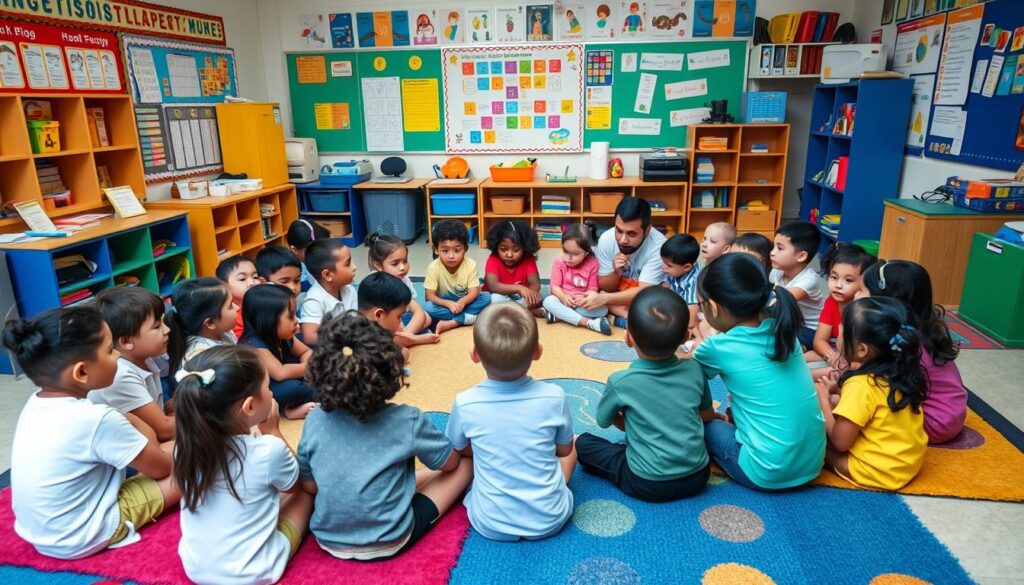Remember those moments when you felt truly heard? Perhaps it was during a heartfelt conversation with a loved one or a teacher who genuinely seemed to care. Now, imagine wanting that same level of connection with your kids, yet facing the all-too-familiar challenge of getting them to listen and focus. As parents, guardians, or educators, we know how it feels to repeat ourselves, to plead for attention, and to watch the blank stares as our words seem to drift away like autumn leaves in the wind. The journey towards effective communication with kids can often feel daunting, yet it is one of the most rewarding pathways we can take.
In this guide, we will explore 20 effective ways to get kids to listen and pay attention, ultimately improving their listening skills and fostering a deeper connection. These parenting tips aim to blend engaging activities with straightforward communication strategies, creating an environment where kids not only listen better but also feel valued and understood. Following these methods can help cultivate improving focus and concentration, enabling kids to absorb information more effectively and respond with respect and engagement.
Key Takeaways
- Active listening enhances communication with children.
- Providing clear instructions and using positive language boosts focus.
- Creating a distraction-free environment significantly improves listening skills.
- Engaging in fun activities can naturally develop attention and concentration.
- Modeling attentive listening reinforces the importance of being present.
The Importance of Effective Communication with Children
Effective communication forms the foundation for fostering a listening environment at home. Understanding different communication styles is crucial for achieving this goal since it directly impacts child behavior management. Research indicates that communication styles can be categorized into three primary types: aggressive, passive, and assertive. A significant 33% of parents typically adopt an aggressive style, expressing themselves through yelling and put-downs. This often leads to fear and a lack of compliance from children.
Conversely, 25% of parents resort to passive communication, speaking softly and cautiously, which can leave children confused about boundaries. Assertive communication remains the most effective method, as 42% of parents exhibit clear, firm, and positive communication coupled with warmth. This approach not only encourages respect and mutual understanding but also aligns seamlessly with effective communication strategies. Remarkably, 95% of children respond more favorably when spoken to with positive language and kind words.
How Communication Styles Impact Listening
Utilizing effective communication strategies, such as incorporating a kid’s name or establishing eye contact, proves to significantly improve listening skills. Studies show that 75% of kids perform better when offered choices instead of receiving straight “no” or “don’t” responses. This empowers kids, enhances their confidence, and nurtures their ability to engage in conversations. Additionally, simplifying instructions and breaking them into manageable steps aids 68% of kids in following directions more easily.
When parents model good manners and maintain consistency in their communication, the likelihood of kids imitating these behaviors increases by 85%. Techniques such as using “I” messages can create a more positive environment, reducing defensiveness and promoting open dialogue. Furthermore, encouraging open-ended questions not only encourages kids to express their feelings but also paves the way for a deeper understanding of their thoughts. Establishing a safe and open environment supports this type of engagement, ensuring that kids feel comfortable sharing.
Understanding Why Kids Don’t Listen
Understanding the reasons kids don’t listen can greatly aid parents in improving communication. Various factors contribute to compliance issues, ranging from emotional states to environmental distractions. Children might resist listening for practical reasons, like a desire for autonomy or focus on other activities.
Common Reasons Behind Non-Compliance
Children often choose not to listen because they feel overwhelmed or distracted by their surroundings. They may not want to be told what to do, particularly when they’re engaged in play. Environmental factors affecting children play a significant role in their ability to focus. For instance, kids with neurodevelopmental issues like ADHD or ASD face unique challenges, making it harder for them to shift their attention or manage emotions. Establishing a connection with your child enhances their receptivity, allowing them to feel valued and understood, thus improving compliance.
Assessing Environmental Influences
The timing and context of requests impact children’s responses significantly. Asking a child to comply while they are deeply engrossed in a game may lead to resistance. Parents should consider a child’s current emotional and physical state before making requests. Additionally, ensuring that instructions are delivered at eye level and in a calm tone can help children process information better. Tailored communication strategies rooted in their environment will foster greater understanding and response, leading to less frustration for both the child and the parent.

20 Effective Ways to Get Kids to Listen and Pay Attention
Getting children to listen can often feel like a challenge. Fortunately, numerous techniques can help enhance their focus and willingness to engage. Implementing strategies for effective direction-giving can create a more receptive environment, allowing kids to absorb information better. Here are some practical tips to achieve that:
Utilize Their Name to Catch Attention
Using a child’s name not only captures their attention but also fosters a sense of connection. This immediate recognition prompts them to focus on what comes next.
Establish Eye Contact
Eye contact is vital for engagement. When adults lean in and make eye contact before delivering instructions, it enhances attentiveness and reinforces emotional connection.
Use Positive Language
Employing positive language can provide encouragement. Affirmative phrases create a supportive atmosphere, making children more willing to listen and respond. Avoid phrases like “don’t be bossy” that might deter healthy expression.
Give Clear and Simple Instructions
Children benefit from straightforward directives. Breaking instructions into manageable parts aids comprehension and reduces confusion. If kids struggle to repeat these directives back, consider simplifying them.
Offer Choices to Empower Them
Letting children make choices empowers them and encourages compliance. For instance, saying “Would you like to start your homework now or in ten minutes?” gives them a sense of control.
Practice Active Listening Techniques
Adopting active listening techniques, such as repeating back what children say, reinforces their importance. Parents set the stage for listening behaviors by modeling these techniques at home.
Use a Gentle Touch
A gentle touch can have a calming effect. Whether it’s a reassuring hand on their back or a hug, physical connection helps children feel secure while processing instructions.
Make Transitioning Easier
Providing clear notices before transitions can alleviate anxiety. Children often require time to adjust to changes, and these notifications prepare them for upcoming activities.
Encourage Open-Ended Questions
Engaging children in open-ended questions promotes critical thinking and enhances mindfulness. Questions like “What do you think we should do next?” encourage them to express their thoughts and ideas.
Implementing Positive Reinforcement Techniques
Positive reinforcement plays a crucial role in effective child behavior management. By using strategies that focus on recognizing effort and celebrating achievements, parents can foster an environment where children feel valued. This approach not only encourages good behavior but also builds a child’s self-esteem, making them more receptive to following directions.
Using Recognition and Praise
One of the essential aspects of positive reinforcement techniques is giving recognition and praise. When parents acknowledge their children’s efforts, it reinforces those behaviors. Statistically, verbal praise has been proven effective in shaping desired behaviors. Celebrating small accomplishments helps children associate good actions with positive feelings. Parents can say phrases like “I’m proud of you for finishing your homework,” to encourage compliance and foster motivation.
Creating Reward Systems
Another effective method involves creating a structured rewards system. For instance, parents can implement a chart system where children earn stars or stickers for completing tasks or following instructions. This not only motivates children but also helps them visualize their progress. Studies show that offering incentives, such as earning $20 for compliance without argument, can significantly influence behavior. Children are likely to engage in desired behaviors when they understand the benefits and rewards associated with their actions.

Strengthening the Parent-Child Connection
Building a strong bond between parents and children is not only essential for enhancing listening skills but also for nurturing a healthy emotional environment. Taking time to engage in meaningful, one-on-one conversations allows for an opportunity to cater to each child’s unique needs and developmental stages. Setting aside just 10 distraction-free minutes daily can make a significant difference in establishing effective communication and strengthening connections.
Taking Time for One-on-One Conversations
Quality time, whether during meal times or specific activities, greatly benefits the parent-child relationship. Having family meals devoid of distractions fosters open discussion and creates a platform for sharing thoughts. This can improve communication habits while reinforcing the value each child has within the family structure. Spending individual time with children not only boosts their self-esteem but emphasizes their importance, reinforcing the parent-child connection.
Modeling Good Communication
Effective communication modeling plays a pivotal role in nurturing a child’s ability to engage constructively. Parents’ use of calm tones and gentle words cultivates a safe space for children to express themselves, promoting understanding and trust. When children observe parents practicing active listening and respectful dialogue, they learn the importance of healthy communication. These foundational skills help avoid misunderstandings and conflicts, fostering a more harmonious relationship.
Conclusion
In this article, we explored a summary of effective communication strategies aimed at fostering listening skills in children. Through well-structured techniques, including the importance of eye contact and empathy, parents can create an environment conducive to better listening and focused engagement. By demonstrating active listening behaviors and employing gentle reminders, caregivers will enable children to feel seen and heard, which is essential for their emotional development.
Moreover, the role of positive reinforcement cannot be understated. By recognizing and praising good behavior, parents help shape children’s understanding of effective self-discipline. Incorporating routines and honest feedback into daily interactions helps solidify these lessons, guiding children toward navigating challenges with confidence and resilience. Implementing these approaches fosters a nurturing atmosphere where children learn not just to listen, but to share their thoughts and feelings more openly.
Ultimately, the strategies discussed in this article empower parents to pave the way for their children’s successful communication and listening abilities. By investing time and effort into effective communication practices, families can nurture stronger connections and promote a happier, well-adjusted life for their children.











